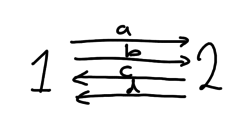Difference between revisions of "M(9,2,3)"
m |
|||
| Line 15: | Line 15: | ||
|defect-morita-inv? = Yes | |defect-morita-inv? = Yes | ||
|inertial-morita-inv? = Yes | |inertial-morita-inv? = Yes | ||
| − | |O-morita? = | + | |O-morita? = No |
|O-morita = <math>\mathcal{O} ((C_3 \times C_3):C_2)</math> | |O-morita = <math>\mathcal{O} ((C_3 \times C_3):C_2)</math> | ||
|decomp = <math>\left( \begin{array}{cc} | |decomp = <math>\left( \begin{array}{cc} | ||
| Line 31: | Line 31: | ||
|sourcereps = | |sourcereps = | ||
|k-derived-known? = No | |k-derived-known? = No | ||
| − | |k-derived = | + | |k-derived = |
|O-derived-known? = No | |O-derived-known? = No | ||
|coveringblocks = | |coveringblocks = | ||
| Line 47: | Line 47: | ||
== Other notatable representatives == | == Other notatable representatives == | ||
| − | |||
| − | |||
== Projective indecomposable modules == | == Projective indecomposable modules == | ||
Latest revision as of 08:43, 23 October 2018
| Representative: | [math]k((C_3 \times C_3):C_2)[/math] |
|---|---|
| Defect groups: | [math]C_3 \times C_3[/math] |
| Inertial quotients: | [math]C_2[/math] |
| [math]k(B)=[/math] | 6 |
| [math]l(B)=[/math] | 2 |
| [math]{\rm mf}_k(B)=[/math] | 1 |
| [math]{\rm Pic}_k(B)=[/math] | |
| Cartan matrix: | [math]\left( \begin{array}{cc} 5 & 4 \\ 4 & 5 \\ \end{array} \right)[/math] |
| Defect group Morita invariant? | Yes |
| Inertial quotient Morita invariant? | Yes |
| [math]\mathcal{O}[/math]-Morita classes known? | No |
| [math]\mathcal{O}[/math]-Morita classes: | [math]\mathcal{O} ((C_3 \times C_3):C_2)[/math] |
| Decomposition matrices: | [math]\left( \begin{array}{cc} 1 & 0 \\ 0 & 1 \\ 1 & 1 \\ 1 & 1 \\ 1 & 1 \\ 1 & 1 \\ \end{array}\right)[/math] |
| [math]{\rm mf}_\mathcal{O}(B)=[/math] | 1 |
| [math]{\rm Pic}_{\mathcal{O}}(B)=[/math] | [math]C_2[/math][1] |
| [math]PI(B)=[/math] | |
| Source algebras known? | No |
| Source algebra reps: | |
| [math]k[/math]-derived equiv. classes known? | No |
| [math]k[/math]-derived equivalent to: | |
| [math]\mathcal{O}[/math]-derived equiv. classes known? | No |
| [math]p'[/math]-index covering blocks: | |
| [math]p'[/math]-index covered blocks: | |
| Index [math]p[/math] covering blocks: |
The representative [math]k((C_3 \times C_3):C_2)[/math] is given by [math]C_3 \times C_3[/math] acted on by an element inverting those of [math]C_3 \times C_3[/math], i.e., it is the group SmallGroup(18,4).
Contents
Basic algebra
Quiver: a:<1,2>, b:<1,2>, c:<2,1>, d:<2,1>
Relations w.r.t. [math]k[/math]: [math]ad=bc[/math], [math]cb=da[/math], [math]aca=bdb=0[/math], [math]cac=dbd=0[/math]
Other notatable representatives
Projective indecomposable modules
Labelling the unique simple [math]B[/math]-module by [math]1,2[/math], the projective indecomposable modules have Loewy structure as follows:
[math]\begin{array}{cc} \begin{array}{ccccc} & & 1 & & \\ & 2 & & 2 & \\ 1 & & 1 & & 1 \\ & 2 & & 2 & \\ & & 1 & & \\ \end{array}, & \begin{array}{ccccc} & & 2 & & \\ & 1 & & 1 & \\ 2 & & 2 & & 2 \\ & 1 & & 1 & \\ & & 2 & & \\ \end{array} \\ \end{array} [/math]
Irreducible characters
All irreducible characters have height zero.
Back to [math]C_3 \times C_3[/math]
